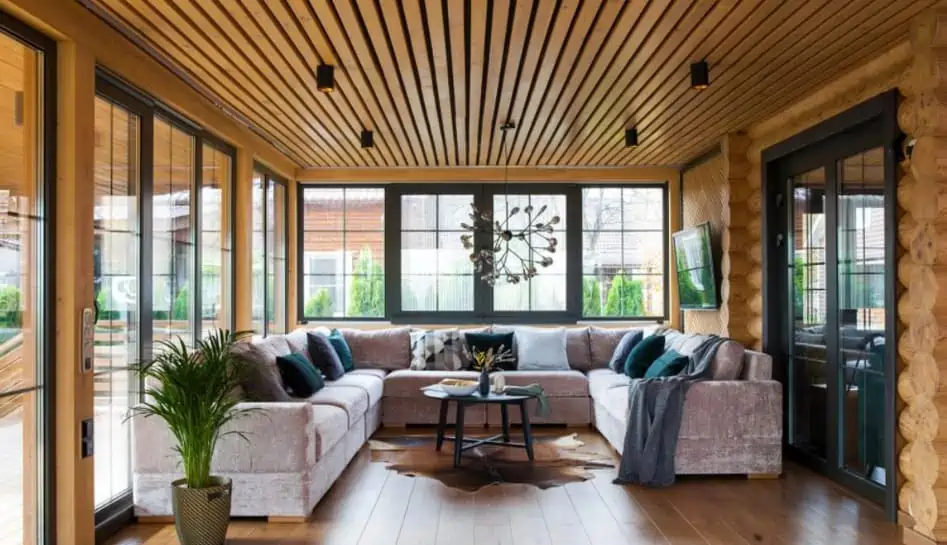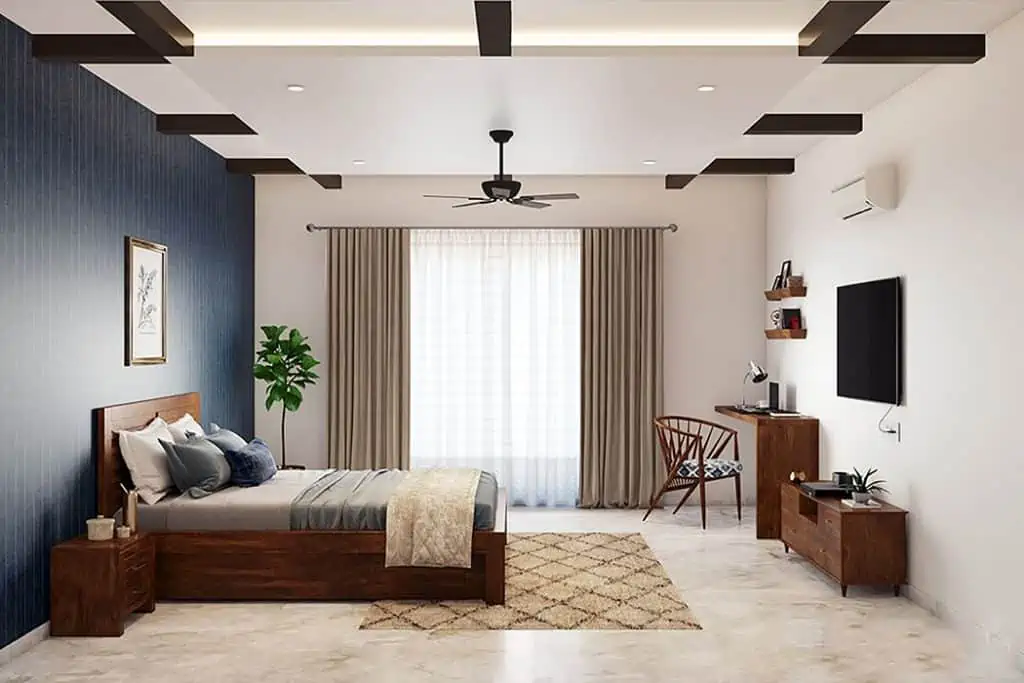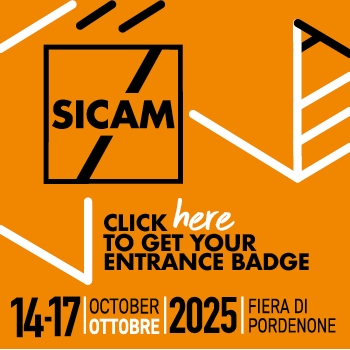False ceiling designs have evolved a lot in the last decade or so. People have realised how false ceilings can alter the look of their homes by giving a modern and elegant look to the interior design. A false ceiling is a drop-down ceiling that has been suspended from the main ceiling using different types of materials like POP, gypsum, PVC, and wood among others. While choosing a material to be used for making a false ceiling you must weigh the list of pros and cons of each type.
Each material can be used for different purposes and areas. For example, Gypsum is very popular because of its durability and cost-effectiveness. Similarly, PVC is an excellent choice for wet areas like kitchens and bathrooms as it is water resistant. Therefore, knowing which material is best for your space is important as it increases the aesthetic and functional value of the room.
In this article, we will look at the list of different types of false ceiling materials and their uses. So, keep reading to select the best material for your false ceiling design.
Contents
Types of false ceiling material
False ceiling material #1 – Plaster of Paris (POP) false ceiling

Image Source: shivasainterprise.com
One of the most commonly used materials for false ceilings, Plaster of Paris (POP) can be moulded to any design as per the preferences of the user and gives a smooth finish. A quick-setting powder, POP hardens immediately when mixed with water. POP false ceilings are budget-friendly and durable.
Advantages
- They are durable, versatile, and provide ease of installation.
- POP false ceiling can also help maintain room temperature.
- It is a relatively cheap wall surfacing & ceiling covering material that provides a fire-resistant interior finish.
Disadvantages
- They are prone to damage by water and thus, are not suitable for areas that are regularly exposed to water or moisture.
- POP false ceilings are installed on the spot thus, they are time-consuming and the labour work is also expensive.
| Also see: False ceiling designs for office and shop to improve productivity(30+ most popular) |
False ceiling material #2 – Gypsum false ceiling

Image Source: neotecture.com
Gypsum (a hydrated sulfate of calcium) is emerging as the first choice for false ceiling materials because of its sound resistance, thermal insulation, lightweight, and cost-effectiveness. Available in factory-made boards, these are easy to install and long-lasting. These boards are also available in large sizes which ensures limited joint lines and a uniform finish. Since the finish is smooth, paint, wallpaper, or laminate can easily be used to complete the overall look of the false ceiling.
Advantages
- They are durable, versatile, and provide ease of installation.
- They are also excellent fire-resistive building materials.
- It is a relatively cheap wall surfacing & ceiling covering material that provides a fire-resistant interior finish.
Disadvantages
- They are more prone to damage by water and thus, are not suitable for areas that are regularly exposed to water as it can lead to warping and fungal growth.
- Their repairs are hard and often require the entire board that they are attached to to be removed.
False ceiling material #3 – PVC false ceiling material

Image Source: designglobe.co.in
PVC or Polyvinyl chloride panels are a popular choice for bathrooms, kitchens, garages, and basements because of their water-resistant nature. Easy to install, these budget-friendly panels are lightweight and colour-fast. PVC false ceiling material is available in a variety of finishes.
Advantages
- They are easy to clean and maintain.
- They are resistant to moisture, termites, and mould.
- PVC false ceilings are comparatively cheap and offer good value for money.
Disadvantages
- When the PVC false ceiling material is burned, it can produce toxic fumes.
- PVC false ceiling panels are not as fire-resistant as other materials such as gypsum or metal.
- They are better suited for indoor use only.
False ceiling material #4 – Wooden false ceiling

Image Source: aluminioslago.com
If you’re looking to give your false ceiling design a warm and rustic look then you can select a wooden ceiling for your home. Available in different natural textures and patterns, these come in the form of boards, blocks, and panels. Although these are expensive compared to the other options, they increase the aesthetic value of a home to give a classic and luxurious look to the interiors.
Advantages
- They are durable and can last long if cared for properly.
- Wood’s porous nature absorbs sound, making a room more acoustically pleasant.
- Wooden false ceilings are also a great insulator for both sound and heat.
Disadvantages
- They demand higher maintenance and care to protect against water, termites and pests, fungal growth, etc.
- They are also more expensive than other false ceiling materials.
- Wooden false ceilings can catch fire easily and thus, are not great from a safety perspective.
| Also see: 31 false ceiling ideas to make a style statement |
False ceiling material #5 – Fiber false ceiling

Image Source: armstrongceilings.com
Made of tar, vegetable fibre, stone, and wood, fiberboards are well-known for their thermal and sound insulation. These are commonly used in shopping malls, offices, and retail stores because of their soundproofing abilities. Although fiberboards are easy to install, they are not a popular false ceiling material choice for homes as they lack visual appeal.
Advantages
- Fibre false ceilings absorb sound and reduce echo to keep the acoustics balanced.
- It also helps in concealing the electrical and plumbing installations and enhances the overall appeal of our home.
- Fibre false ceilings can reflect and disperse light, preventing the need for excessive artificial lighting and also improving air conditioning efficiency, thus reducing energy consumption.
Disadvantages
- They demand higher maintenance and care to protect against water, termites and pests, fungal growth, etc.
- They reduce the height of the ceiling and make the room look a little smaller.
- These false ceilings are prone to water spots and sagging and they also attract mould and mildew.
False ceiling material #6 – Metal ceiling design

Image Source: samsui.com
Made of brass, steel, copper, galvanized iron, and aluminium, these metal panels are suspended from the main ceiling. These are strong and easy to maintain. Metal panels are available in different finishes to give a shiny look to the decor and can be used to house electric wire and AC ducts.
Advantages
- They have great strength and show resilience.
- They are super easy to clean and show resistance to moisture.
- Metal does not catch fire easily thus, improving the safety of the space.
Disadvantages
- They are also more expensive than other false ceiling materials.
- Metal false ceilings can be noisy during rain and hailstorms.
False ceiling material #7 – Glass false ceiling

Image Source: euroceil.com
Glass offers transparency which is used to create an illusion of space. These glass ceiling panels are commonly used in restaurants, jewellery shops, and showrooms to increase brightness. A good insulator of heat, glass is available in various colours and patterns. Glass can also be used in living areas to create an eye-catching look.
Advantages
- Glass false ceilings enhance the natural light distribution making the room appear bigger.
- They can be customized with decorative patterns or colours.
- They are fire-resistant and good heat insulators.
Disadvantages
- They demand higher maintenance and regular cleaning of the glass panels as they attract dust particles.
- Glass as a material for false ceilings is also very fragile and has to be handled cautiously.
- Glass false ceilings are expensive and require professional installation.
False ceiling material #8 – Synthetic leather and fabric ceiling

Image Source: moneyhaat.com
Fabric and synthetic leather false ceilings are made by moulding cloth or faux leather into different designs. These can be used for a specific purpose like an event or an exhibition but are not durable in the long run as they are prone to damage and dust.
Advantages
- It is recommended for temporary work; it has a strong visual appeal because of its fabric texture.
- These false ceiling materials are versatile and provide endless design possibilities.
- It can also be used to improve acoustics.
Disadvantages
- It’s less common and can be difficult to clean.
- Synthetic fabric false ceiling materials also do not last as long as other materials.
False ceiling material – Application areas and price range
| False ceiling material | Application areas | Price range |
| POP false ceiling | Kitchen, bedroom, living room, lobby | Rs. 95 – Rs. 105/sq ft |
| Gypsum false ceiling | Living room, bedroom, and commercial spaces | Rs. 75 – Rs. 110/sq ft |
| Fiber false ceiling | Shopping malls, offices, retail stores, hallway | Rs. 65 – Rs. 450/sq ft |
| Wooden false ceiling | Living room, bedroom, offices | Rs. 850 – Rs. 1200/sq ft |
| Metal false ceiling | Industrial and commercial buildings – airports, malls, etc. | Rs. 80 – Rs. 130/sq ft |
| Glass false ceiling | Malls, shops, showrooms, living room | Rs. 350 – Rs. 600/sq ft |
| PVC false ceiling | Bathroom, kitchen, garage, basement | Rs. 160 – Rs. 185/sq ft |
| Synthetic leather and fabric | Events and exhibitions | Rs. 200 – Rs. 500/sq ft |
Nowadays, false ceilings are an important part of the interior design of a space. With the correct material and design, you can transform the overall look of a room. A good false ceiling also helps in controlling the temperature of the house.
The perfect material when paired with a matching colour palette and proper lighting will also create a style statement for your home. We have curated a list of the best false ceiling materials you can buy from. So, go ahead and submit your enquiries to get the best quote for the perfect false ceiling material for your space.
FAQs
What is the most commonly used false ceiling material?
Gypsum and Plaster of Paris are the two most commonly and widely used false ceiling materials. They are versatile, durable, and affordable than other false ceiling materials like glass, wood, or metal. These materials are also low maintenance and can be moulded into various shapes and designs elevating the aesthetic of spaces. These materials are also heat and fire-resistant and thus, provide safety.
Which false ceiling material is ideal for bathroom spaces?
Acrylic sheet is a popular false ceiling material for bathroom spaces today due to its availability in colours and its lightweight nature. It is a fibre material and the most common choice for bathrooms. Gypsum boards are a cheaper option for bathroom false ceilings than acrylic sheets but have to be regularly cleaned.
What are the factors to consider while choosing a false ceiling material?
Selecting the right false ceiling material ultimately depends on a variety of factors like budget, personal taste and preferences, and the intended use of the space along with other requirements like fire-resistant and soundproofing properties. There are various materials, as we have discussed above in the false ceiling materials list, with their advantages and disadvantages and you should choose what suits your intended goals and purpose.
How to clean and maintain a false ceiling?
There is no exhaustive list for cleaning the different false ceiling materials. Moreover, choosing the right false ceiling materials in the right spaces can save you from the extra hassle of regular cleaning too. A few simple steps can be followed to make your false ceilings last longer like using a soft-bristled brush or mop to clean the dust and debris while using a mild detergent and a soft cloth for sticky stains.
*The featured image used in this article is from Pinterest.com
False ceiling price per sq ft: POP, PVC, Gypsum & wood ceiling cost
A beautiful false ceiling completes the look of your room most exquisitely. Over the years, it has gained popularity, and now


























